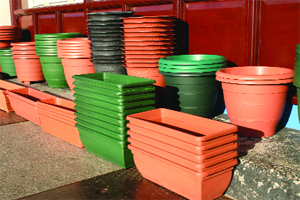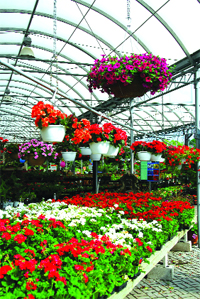
Features
Crop Culture
Inputs
Growing in the Green: Learning from the past
March 14, 2008 By Melhem Sawaya
The 1972 oil crisis caused significant increases in heating costs and a
shortage of plastic containers. And yet the horticulture industry not
only survived the crisis, but it grew substantially.
The 1972 oil crisis caused significant increases in heating costs and a shortage of plastic containers. And yet the horticulture industry not only survived the crisis, but it grew substantially. When it was all over, the industry was much healthier. Heating expenses, after the shortage, were much lower due to the use of more efficient boilers. As well, more plastic greenhouses were built to take advantage of their superior heating efficiency compared to glass.
When the crisis was over, the industry was ready to take on the quickly expanding market with heat-efficient, low-cost greenhouses. There was an incentive for new plastic container producers to serve the market, and this curbed the monopoly of a single supplier.

|
| The 1972 oil crisis caused major increases in heating costs and a shortage of plastic containers. |
In the early 1980s, interest rates reached 18 to 19 per cent, and this turbo-charged research into technologies to spur more production per square foot. Along with this, the industry increased labour efficiency and learned how to produce the same crops in about half the time. When interest rates subsided, the industry had more tools, skills and knowledge than ever before. If not for the extremely high interest rates, it would have taken another 10 to 15 years to accomplish what we were forced to achieve in three or four years. Grants were more readily available for research and everyone embraced the new technologies.
By about the mid-to-late ’90s, mega chain stores, for the first time, were using more product than independent garden
centres. A new game faced the horticulture industry.
• Sales volumes increased by five to 10 per cent annually.
• Prices stayed the same.
• Costs started climbing due to production input costs.
• Costs also increased due to different demands by the high-volume chains; the grower didn’t have much ability to negotiate.
• While sales were increasing by five per cent, production capability was increasing 15 to 20. More supply than demand is definitely a disaster and a recipe for lower prices and greater buyer control.
• U.S. growers tried to combat the new reality by building more greenhouses, the thinking being they could keep the same profits by increasing production volume. Unfortunately, because of the unlimited supply and only slight sales increases, this only gave buyers even more ammunition to buy at cheaper prices.
• Canadian growers weathered the last storm better because the exchange rate had dropped to as low as $1.58.
• Stores used horticulture products as loss-leaders, which translated into almost no profit for the stores or the grower. In many cases, the product went into garbage bins, which led to three decisions by the stores:
a) Stores would no longer pay for shrinkage, which, much of the time, was as high as 30 per cent.
b) To reduce shrinkage, growers were forced to maintain their products in the stores at their own cost.
c) Weekly products diminished greatly, if not disappeared, because shrinkage was much greater for them than for
holiday products. Holiday plants sell faster, resulting in less un-saleable inventory. Many stores stopped carrying weekly products.

|
| With lower margins, growers must figure out how to decrease costs or increase prices. |
Breeders/brokers started approaching the big stores with programs and many varieties that were not popular in all regions of North America due to weather variances. This had a large negative impact in two ways:
• Production-wise it was a challenge. These programs were not always tested under different conditions.
• Customer appeal is not the same in every state or province. The weather also plays a great role in product acceptance.
• The urgency of having new products led chain buyers to select products that might be good as long as they were exclusive and different.
• The race by stores to be the first with a product led to them putting things out before they were ready or the customer was even interested. This led to shrinkage and diminished potential sales.
• The stigma, for some buyers, of the sale price going above a certain level – such as $9.99 or $19.99 – reduced sales drastically. It caused them to sell at a loss or at minimal profit margins.
• Reluctance by buyers to choose different products too often resulted in them sticking with traditional ones. When these did not perform well in gardens, subsequent sales were killed by those customers and others with whom they shared their negative experiences.
• By not informing customers on how to take care of their product, we shrink the market and have fewer repeat customers.
These are most of the factors that led us to where we are now. But it’s easy to analyze the past. What about the future? Understanding our history means we can learn from our mistakes and build on our successes.
In life, there are absolute truths and relative truths. We can always learn from what’s gone on before. But everything
is subject to interpretation. When reflecting on past experiences to know the absolutes and relative truths, it’s important to understand what’s happening now, in 2008, and what happened years ago.
The dictionary describes absolutes as independent and un-modifiable: not depending on or qualified by anything else. It describes relative as changing with circumstances: not permanently fixed but having a meaning or value that can only be established in relation to something else and will change according to circumstances or context.
Absolute truths from the past from which we can learn include:
1 When sales of certain products were increasing by five to 10 per cent, we should have been looking for a wild goat, a new product that has the potential of generating much higher margins but also has greater potential risks. This is why wild goats should not exceed five per cent of our plan.
The other 95 per cent of our production, which is called the cash cow, is the high-volume production of a proven product. They usually have low profit margins. The absolute truth is that if we don’t keep our production in these two perspectives in mind when sales are good, we will not be able to stem the tide when sales begin to slide. This is not the time to invest in wild goat projects. While they might seem worthwhile, they are still unproven, and this is not time to risk money we can’t afford
to lose.
The absolute truth is to invest five per cent in wild goat projects when sales are on the upswing and the profit margin is healthy. This should not happen only every three to five years but should be on a continuous basis. The relativity in this process, from one operation to another, is that while one grower can be dedicated to wild goat projects, another does not have the resources to take those risks. Dedication to wild goat projects changes according to a grower’s financial status, “know-how,” manpower, and the ability to know how best to introduce and increase the sales of these products. They must also be the sole beneficiary of the new product for as long as possible before everyone else turns them into a cash cow.
2 The absolute truth is that when margins are lower, we must figure out how to decrease costs or increase prices. Only when we know the cost of every item can we determine how to lower them, and we cannot increase prices unless there has been value added, such as better packaging, new sizes, etc. The relative truth is that if we deal with only one customer, we are at their mercy and our situation is not as flexible as if we have several customers. Also, it is relative to what kind of relation, history, and confidence level the buyer has with the grower.
3 The absolute truth about increased production without the equivalent increase in sales is that prices will drop. The
relative truth is that, taking into consideration their specific cost of production, this could affect some growers more than others.
4 The absolute truth is that when you sell only on price, it is only a matter of time before the whole company collapses. Cutting prices is the number one recipe for calling the banker to take over the business. The relative truth is that some growers can last a few years longer than others, but the final outcome is the same.
5 The absolute truth is that the only way to increase sales is to make the customer aware of what the product is going to do and then ensure it performs as described. Only marketing and educating consumers about the beauty and benefits of our products will ensure success. Our industry spends around half of one per cent of total expenditures on marketing, while every other successful industry spends more than 15 per cent. This has to be done when everything is sold, because then we will have the five, 10 or 15 per cent to put towards advertising. Generally speaking, any plant marketing is beneficial for the whole industry.
In summary, this industry has endured tough times before. And yet in every instance, those periods were always followed by boom times lasting many years. The current situation is no different. All signs suggest that, within one season, or two at the most, the good years will return as long as we learn from our mistakes, minimize them and capitalize on our successes. Growers should recognize the absolute truths about their operation and accept that they are here to stay. They should then identify the relative truths, and work on improving every aspect of them.
One thing to remember is that we’re not talking about one operation or two, or even one or two countries. These are global conditions, though the severity may differ from one grower or region to another. The reality is that if one operation suffers, the ripple effect is felt by everyone.
It was said over 2000 years ago: “for the body is not one member but many, and whether one member suffers all members suffer with it.”
We can say, after reviewing some of the facts from the past 35 years: “any member that gets healthier and stronger will create a ripple effect to make the whole horticulture body (industry) much healthier!”
Melhem Sawaya of Focus Greenhouse Management is a consultant and research coordinator to the horticultural industry. Comments on this or any other article are always welcome by e-mailing focussawaya@kwic.com .
Print this page